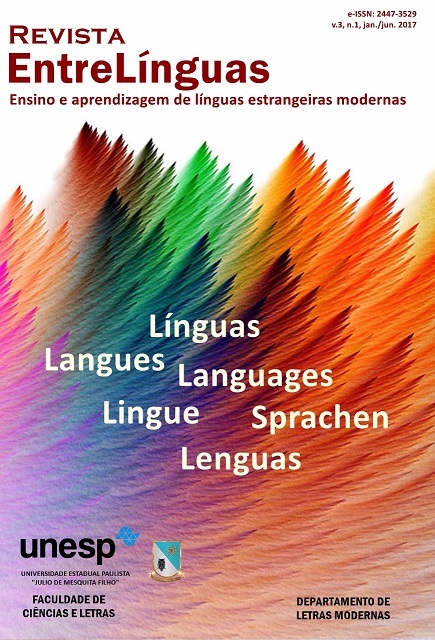The role of oral corrective feedback in L2 Portuguese classrooms
DOI:
https://doi.org/10.29051/rel.v3.n1.jan-jun.2017.9015Keywords:
Second language acquisition. Corrective Feedback. L2 Portuguese.Abstract
Languages are generally acquired along with and for others, in varied environments which influence second language (L2) learning. One of the most important influences of the linguistic environment is that it provides learners with information about the incorrectness of their utterances (ORTEGA, 2009). This process is referred as Corrective Feedback (LYSTER; RANTA, 1997, RUSSEL; SPADA, 2006), which is a complex phenomenon that has different functions in formal L2 instruction. The purpose of the current study was to investigate the types of oral CF in L2 Portuguese classrooms and to analyze how learners responded to CF provided by their teachers. The data presented were obtained from the observation of lessons in an elementary and an intermediate group of a Portuguese course offered at a private American university. The results of this observational study show that elicitation, explicit correction and metalinguistic feedback are the main CF methods employed by the teachers.
Downloads
References
CHAUDRON, C. A descriptive model of discourse in the corrective treatment of learners’ errors. Language Learning, Ann Arbor, v. 27, n. 1, p. 29-46, 1977.
ELLIS, R.; BASTURKMEN, H.; LOEWEN, S. Learner uptake in communicative ESL lessons. Language Learning, Ann Arbor, v. 51, n. 2, p. 281-318, 2001.
GASS, S. M. Input, interaction, and the second language learner. Mahwah, NJ: Lawrence Erlbaum Associates, 1997.
JOUET-PASTRÉ, C. M. C. et al. Ponto de Encontro: portuguese as a world language. Upper Saddle River, NJ: Pearson/Prentice Hall, 2013.
LOEWEN, S. The role of feedback. In: GASS, S. M.; MACKEY, A. (Org.). The Routledge handbook of second language acquisition. London, New York: Routledge, 2012, p. 24-40.
LYSTER, R.; MORI, H. Interactional feedback and instructional counterbalance. Studies in Second Language Acquisition, Cambridge, v. 28, n. 2, p. 269-300, 2006.
LYSTER, R.; RANTA, L. Corrective feedback and learner uptake: negotiation of form in communicative classrooms. Studies in Second Language Acquisition, Cambridge, v. 19, n. 1, p. 37-66, 1997.
LYSTER, R.; SAITO, K.; SATO, M. Oral corrective feedback in second language classrooms. Language Teaching, Cambridge, v. 46, n. 1, p. 1-40, 2013.
ORTEGA, L. Understanding second language acquisition. London: Hodder Education, 2009.
RUSSEL, J.; SPADA, N. The effectiveness of corrective feedback for the acquisition of L2 grammar: a meta-analysis research. In: NORRIS, J. M.; ORTEGA, L. (Org.). Synthesizing research on language learning and teaching. Amsterdam: Benjamins, 2006, p. 133-164.
Downloads
Published
How to Cite
Issue
Section
License
Copyright (c) 2017 Revista EntreLínguas

This work is licensed under a Creative Commons Attribution-NonCommercial-ShareAlike 4.0 International License.
Os manuscritos aceitos e publicados são de propriedade da Revista EntreLínguas. Os artigos publicados e as referências citadas na Revista EntreLínguas são de inteira responsabilidade de seus autores.
Transferência de direitos autorais – autorização para publicação
Caso o artigo submetido seja aprovado para publicação, já fica acordado que o(s) autor(es) autoriza(m) a UNESP a reproduzi-lo e publicá-lo na EntreLínguas, entendendo-se os termos “reprodução” e “publicação” conforme definição respectivamente dos incisos VI e I do artigo 5° da Lei 9610/98. O artigo poderá ser acessado pela rede mundial de computadores (Internet), sendo permitidas, a título gratuito, a consulta e a reprodução de exemplar do artigo para uso próprio de quem a consulta, desde que haja a citação ao texto consultado. Essa autorização de publicação 328 EntreLínguas, Araraquara, v. 1, n .2, p. 323-328, jul./dez. 2015 não tem limitação de tempo, ficando a UNESP responsável pela manutenção da identificação do(s) autor(es) do artigo. Os artigos publicados e as referências citadas na Revista EntreLínguas são de inteira responsabilidade de seus autores.











